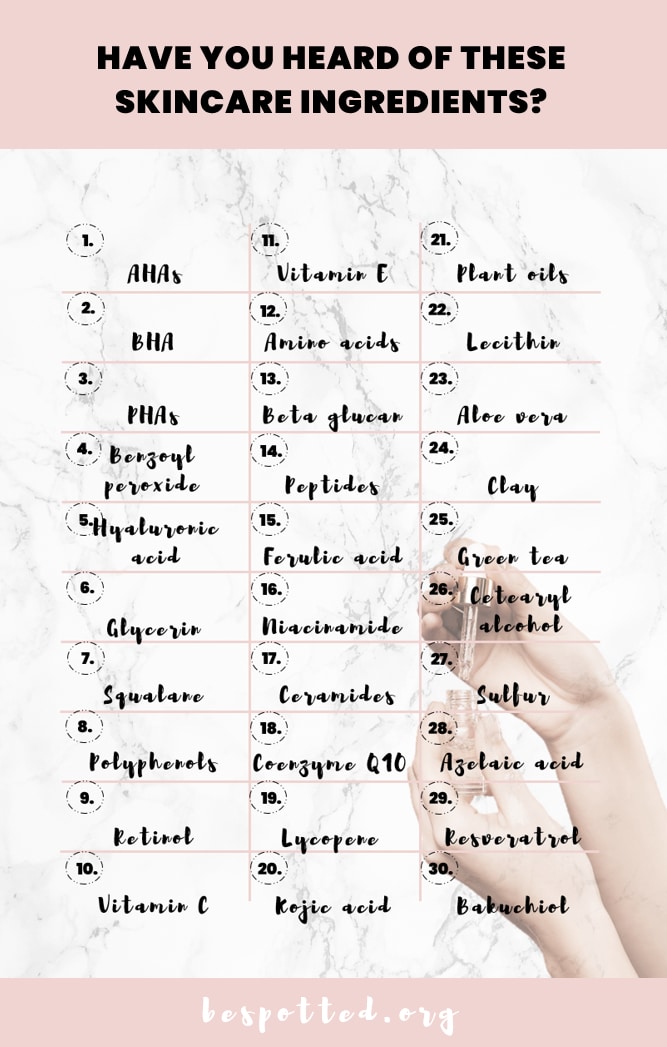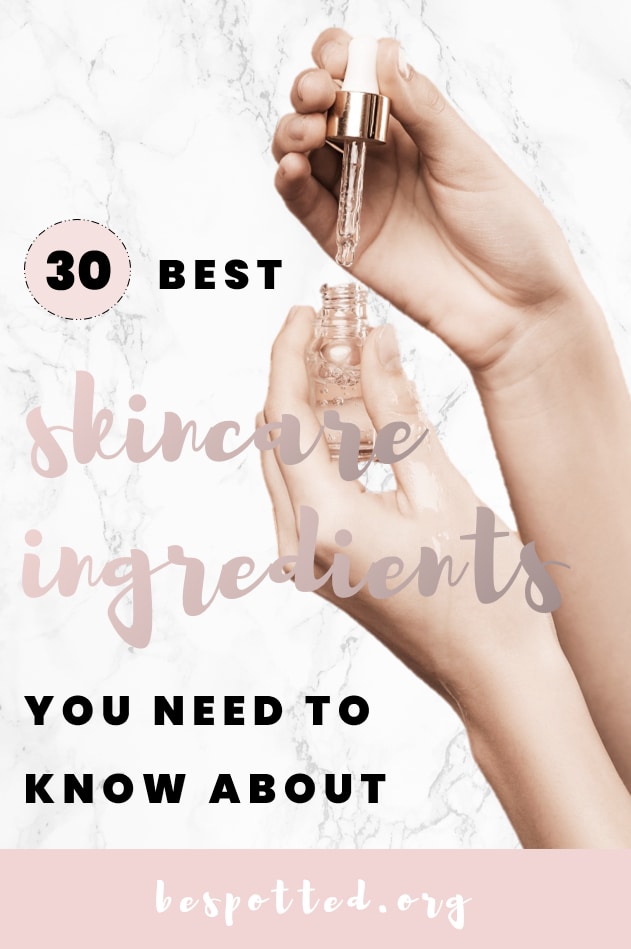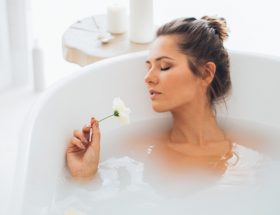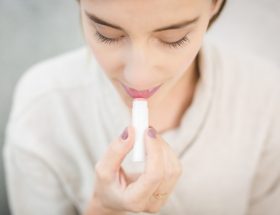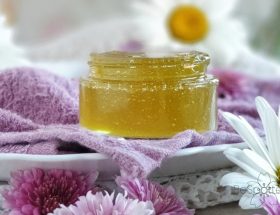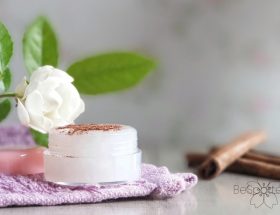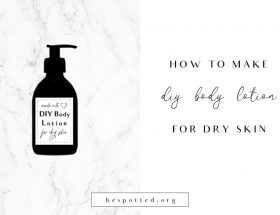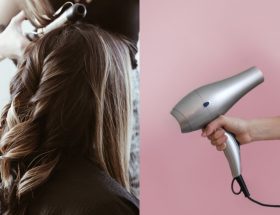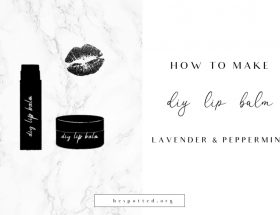This post may contain affiliate links. Any sales made through such links will reward me a small commission – at no extra cost for you!
Have you ever wondered what those extensive lists of ingredients on cosmetic labels actually mean? What certain skincare ingredients say about the product and how each of them affects your complexion?
I know that trying to decipher those barely pronounceable things can give you a headache. But, to understand which products can actually help your skin and which just look good on the shelves, it is important to have at least a basic understanding of common ingredients in skincare products.
I’ve gathered here a list of 30 often used skincare ingredients. You can probably find most of them in the products you are already using. And many are worth further exploring and trying to incorporate them into your skincare routine.
So, here’s why these popular skincare ingredients are so important and what each of them can do for your skin:
30 Skincare Ingredients You Need To Know About

1. AHAs
AHAs (alpha hydroxy acids) can be found in a variety of skincare products, from cleansers to toners and from anti-acne to anti-aging products. Their primary purpose is to dissolve dead skin cells and exfoliate the skin.
By removing the surface dry, dull layer of skin cells, AHAs promote the skin natural renewal process. This can also help in treating acne, reducing surface wrinkles and fine lines and fading skin discolorations.
Exfoliation also increases other products’ absorption into the skin. All of this purifies and rejuvenates the skin, evens out the skin tone and brightens the complexion.
There are seven types of AHAs that are commonly used as skincare ingredients. Out of them, the most famous are glycolic, lactic and citric acid.
2. BHA
Like AHAs, BHA (beta hydroxy acid) ‘s purpose is to exfoliate the skin. However, while AHAs mostly stay on the very surface of the skin, BHA penetrates further into the skin, cleansing and unclogging the pores.
BHA is often used in products created for acne prone skin. It dissolves the dead skin cells, dirt and excess sebum and thoroughly cleanses the skin. It is also said to have antibacterial and anti-inflammatory properties, which makes it perfect for treating acne, blackheads and whiteheads.
The only BHA used in skincare products is salicylic acid. It can be produced synthetically or derived from the willow tree bark.
3. PHAs
Polyhydroxy acids (like gluconolactone and lactobionic acid) are another kind of skin exfoliating acids. They have the same effect to the skin as AHAs, except that their molecules are larger, so they can’t penetrate the skin as well as alpha hydroxy acids can.
This means that PHAs exfoliate only the uppermost layers of skin, promoting smoothness and giving you that fresh, bright look. But, they are much less likely to cause sensitivities and irritations than AHAs.
This feature doesn’t necessarily make them better or worse than AHAs. It all depends on your skin and its individual needs. If you’d like a more potent exfoliator, choose a product based on AHAs. If your skin is sensitive and prone to redness, opt for PHAs.
4. Benzoyl Peroxide
You can mostly find benzoyl peroxide in over-the-counter acne treatments. It can help clear out the skin, thoroughly purify it and soothe acne inflammations.
When applied topically, benzoyl peroxide releases oxygen into the pores. That way, it kills acne-causing bacteria, treats and prevent breakouts. Benzoyl peroxide also exfoliates the skin and encourages it to produce new, healthy skin cells.
Both benzoyl peroxide and salicylic acid are amongst the best skincare ingredients for acne prone skin. However, products that combine both might be way too drying and irritating.
You can opt for one of them (experiment to see which one your skin prefers). Or, try to mix and match them through different products. If, for example, your face wash is based on salicylic acid, choose a spot treatment that contains benzoyl peroxide.
5. Hyaluronic Acid
Hyaluronic acid is a humectant that has an amazing ability to hold up to 1000 times its weight in water. It attracts water molecules to the surface of your skin, hydrating it and making it plump, smooth and bright.
Hyaluronic acid is a non-irritating skincare ingredient. It is suitable for all skin types (as all skin types need hydration), but it is especially beneficial for aging or dehydrated skin. Oily skin also loves it, since it hydrates the skin without leaving a greasy residue.
Hyaluronic acid is a pretty big molecule that our skin cannot easily absorb. Even so, it is very beneficial, replenishing and reinforcing the outermost layer of the skin. However, the inner layers of the skin also need hydration.
That is why you can find many products that contain both hyaluronic acid and sodium hyaluronate. Sodium hyaluronate is the sodium salt of hyaluronic acid. It has all the same benefits for the skin, but a much smaller molecular weight, so it easily penetrates the skin.
6. Glycerin
Glycerin is another humectant that hydrates the skin and makes it plump and supple. It also reinforces the skin’s natural protective barrier, protects the skin against the elements and promotes the wound healing process.
Glycerin can be either natural (derived from animal fats or vegetable oils) or synthetic. It has a syrupy texture, and it is clear, has no color or scent. It should never be used on its own, only diluted or as a part of skincare products.
Being a humectant, glycerin has a very similar effect on the skin as hyaluronic acid. However, glycerin has smaller molecules, so it gets better absorbed than full size HA molecules. It can, on the other side, leave a bit greasier feel on the skin.
7. Squalane
Squalane is a lightweight lipid that acts as an emollient and helps seal moisture into the skin. It is a derivative of squalene, which is naturally present in healthy skin.
Squalane is a great moisturizer that improves the function of the skin barrier, softens dry patches and prevents future drying out. It also has antioxidant properties. This makes it a great anti-aging agent that helps reduce wrinkles and fine lines and prevents the formation of new ones.
Due to its lightweight texture and similarities with sebum, squalane gets easily absorbed into the skin and it doesn’t leave a greasy residue. It is suitable for all skin types, even for oily and acne prone skin.
8. Polyphenols
Polyphenols are a large group of antioxidants that can be naturally found in wine, chocolate, grapes, pomegranate, green tea, vegetables, etc. The most well-known polyphenols are flavonoids, tannins, ellagic acid and anthocyanins.
As all antioxidants, polyphenols have an important role in maintaining your skin youthful and healthy. They fight against free radicals, protect the skin from sun damage and help repair and rejuvenate the skin. They can also prevent and even somewhat reverse aging signs like fine lines, wrinkles and sun spots.
Whether you eat food rich in polyphenols or apply them topically, they can surely help a lot to maintain your skin smooth, youthful and glowing. You can find them in many types of skincare products, especially in anti-aging cosmetics.
9. Retinol
Retinol (or vitamin A) is mostly used as an anti-acne and anti-aging ingredient, as well as an exfoliating agent. It increases the rate of skin cell turnover and stimulates the production of collagen, enhancing the skin renewal process.
Retinol makes the skin firm and plump and improves its overall texture. It can smooth out your skin, reduce wrinkles and fine lines and significantly improve skin imperfections, giving you an even, glowing complexion.
Retinol has gotten a suspicious reputation, as many people experience skin sensitivity, redness, flaking and dryness when they start using it. These side effects are only temporary and they are a part of the process.
But, you should avoid using retinol if your skin is very sensitive or if you suffer from eczema, rosacea or psoriasis. Also, retinol can make your skin more sensitive to UV rays.
10. Vitamin C
Vitamin C is, no doubt, one of the best skincare ingredients and you can find it in many facial and eye creams, serums and moisturizers. It is a powerful antioxidant that protects the skin against free radicals and reduces the oxidative stress.
Vitamin C is best known as an anti-aging ingredient, though it has a beneficial effect to all skin types and conditions. It can help both prevent and treat existing wrinkles, fine lines and dark spots.
Vitamin C is also a great skin brightening agent. It smoothes the skin’s surface, fades skin imperfections and fights dullness. It gives you an even, glowing complexion and youthful appearance.
11. Vitamin E
Another antioxidant, very common in contemporary moisturizers, serums and eye creams. The term vitamin E actually refers to a group of 8 oil-soluble antioxidant compounds, but you can mostly find it on skincare labels as tocopheryl acetate or tocopherol.
There is a good reason why vitamin E is so popular anti-aging ingredient. It repairs damages and helps the skin to heal and recover. Also, being an antioxidant, it prevents oxidative damage to the skin cells and prevents the formation of premature aging signs.
Vitamin E moisturizes the skin and improves the skin barrier function. It also has an anti-inflammatory effect to the skin, helping to soothe irritations and sensitivities. It works best when paired with vitamin C.
12. Amino Acids
Amino acids are the building blocks of peptides and proteins, which are very important for the skin’s texture, firmness and overall health and appearance. They can be divided into two types – essential and non-essential.
Amino acids play an important role in maintaining the skin well hydrated by helping the moisture to move throughout the skin. Some amino acids also have antioxidant properties, others promote cellular repair or help reinforce the skin’s supportive elements.
All of this makes amino acids crucial for the skin’s normal functioning. They maintain the skin bright and healthy and can even somewhat reverse the effects of UV damage. Amino acids you should especially pay attention to on the ingredients lists are glycine, glutamine, histidine, lysine, leucine, arginine, proline, methionine, etc.
13. Beta Glucan
Beta glucan is one of the lesser known skincare ingredients that can help you a lot to soothe your skin and repair the damage. Especially if your skin is reactive and prone to irritations, you will love products that contain beta glucan.
This polysaccharide moisturizes the skin, soothes it and protects it against free radicals. It can repair compromised skin barrier and enhance the treatment of eczema, dermatitis, small wounds and other skin damages.
Also, believe it or not, some tests have shown that beta-glucan can hydrate the skin 20% more than hyaluronic acid! It plumps up the skin, makes it smooth and supple and helps reduce the appearance of aging signs.
14. Peptides
Peptides are strings of amino acids, which are building blocks of proteins in our skin. And some of these proteins (like collagen and elastin) are very important for a healthy, youthful complexion.
Peptides have a huge impact on the skin’s texture, suppleness and general condition. They promote the skin renewal process by signaling the skin that it needs to produce more collagen, elastin and even hyaluronic acid.
By stimulating the skin to repair and renew itself, peptides maintain the skin healthy and youthful and make it smooth, elastic and resilient. There are many different types of peptides, with different ways they benefit the skin. Copper peptides seem to be especially popular at the moment.
15. Ferulic Acid
This natural antioxidant can be found in rice, oats and the seeds of apples and oranges. When applied topically, it can help reduce the sun damage, prevent the oxidative stress damages and slow down the aging process.
You can mostly find ferulic acid in leave-on products, such as serums and moisturizers. It is basically an anti-aging ingredient that rejuvenates the skin and helps prevent future damages. It can also help soothe skin inflammation processes.
Ferulic acid works well with most other skincare ingredients with antioxidant properties. It can also help improve the efficacy and stability of vitamins C and E.
16. Niacinamide
Niacinamide is a form of vitamin B3 that is said to have even better skin brightening abilities than vitamin C. It prevents the transfer of pigment within the skin and that way reduces dark spots and evens out the skin tone.
But, brighter, clearer looking skin is only one of the niacinamide’s amazing skincare benefits. It also restores the skin, repairs damaged DNA, has anti-inflammatory properties and prevents premature aging signs.
Niacinamide also plays an important role in maintaining the skin well hydrated. It improves the synthesis of healthy fats and reinforces the skin’s natural protective barrier. It is suitable for all skin types, even for sensitive skin and it works best in low concentrations (1 – 2%).
17. Ceramides
Ceramides are lipids that make up over 50% of skin’s composition. They are often described as the “mortar between bricks”, the bricks being the skin cells.
So, basically, ceramides keep the skin cells together and create a protective layer on the surface of the skin. This protective barrier prevents the loss of moisture and protects the skin against the elements.
By maintaining it optimally hydrated and protected, ceramides make the skin supple, plump, smooth and with significantly reduced wrinkles and fine lines. They soften the dry patches, reduce sensitivities and prevent dehydration and dull looking complexion.
However, as we age, the effectiveness of ceramides in our skin becomes compromised, leaving the skin exposed to pollution, irritants and drying agents. That is why it is so important to replenish the levels of ceramides by using cosmetics that contains them.
18. Coenzyme Q10
Coenzyme Q10 is a substance naturally produced in our body. But, as with most good stuff, its synthesis declines as we age, so we need an external source to replenish it.
CoQ10 is a fat-soluble antioxidant. It works as a shield that protects the skin against pollution, UV radiation and other negative influences. It can help reduce the appearance of photo-aging symptoms, such as fine lines, crow’s feet and age spots.
Coenzyme Q10 keeps the skin cells energized, helping them to get rid of toxins and stay active and healthy. It also improves the production of collagen and elastin and maintains the skin firm and bright.
19. Lycopene
Lycopene is a carotenoid pigment that, amongst other benefits, can help protect the skin against free radicals. It can be derived from red fruits and vegetables, such as watermelon, tomato, papaya, mango, pink grapefruit and rose hips.
This phytochemical has natural antioxidant and anti-inflammatory properties. It is said to be twice as powerful an antioxidant as beta-carotene and 10 times more effective than vitamin E!
Though all skin types can use some extra lycopene, it is especially beneficial for acne prone, oily and combination skin types, as well as, of course, mature skin. Lycopene can stimulate the production of collagen, reduce enlarged pores and give you a smooth, even skin and a glowing complexion.
20. Kojic Acid
Kojic acid is a skin lightening ingredient that can help you fade dark spots, hyperpigmentation or acne marks. It has a similar effect to the skin as hydroquinone, but it is less aggressive.
Kojic acid blocks the overproduction of melanin by inhibiting tyrosinase (the enzyme that produces melanin). That way, it fades discolorations and lightens skin imperfections.
If you need an ingredient to help you even out your skin tone and get rid of melasma, dark aging spots, acne marks or discoloration caused by sun damage, you should definitely consider giving kojic acid a chance. It works well on its own. Or, for persistent discolorations, it can be paired with other skin lightening ingredients.
21. Plant Oils and Butters
Natural oils are full of healthy fats, nutrients and antioxidants. When applied topically, they strengthen the skin’s lipid barrier, help protect the skin against the environment and prevent drying out.
Depending on the ratio between some fatty acids in the oil, plant oils can be very thick and greasy (high concentrations of oleic acid) or lightweight and fast absorbing (contain more linoleic acid).
The first type would be more beneficial for dry, aging skin, while the second type is often recommended for treating oily, acne prone skin. This, though, depends a lot on the skin’s individual needs.
Some of the best plant oils to look for in a product are jojoba, sweet almond, flaxseed, coconut, rosehip seed, grapeseed, pomegranate seed, macadamia oil, as well as shea, cocoa and mango butter.
22. Lecithin
Lecithin is often used as a cosmetic ingredient because of its emollient properties and as a water-binding agent. It is a mixture of the diglycerides of stearic, palmitic and oleic acids that naturally occurs in egg yolk, soybeans and plant and animal products.
Lecithin replenishes and restores the skin. It is a skin conditioner that works to improve dry and damaged skin. Due to its high concentration of fatty acids, it moisturizes the skin and makes it soft and smooth.
Lecithin can also be used as a penetration enhancer. However, it is most often used to improve the skin’s barrier function, which is why you can often find it in restorative products intended to treat dry, damaged or mature skin.
23. Aloe Vera
Aloe vera gel has versatile and powerful benefits for all skin types. It can be used pure, fresh from the plant. You can also find many cosmetic products that contain aloe vera gel, juice, extract, powder, oil…
Aloe vera gel is high in moisture. It replenishes the skin and makes it plump and bright. The gel is also rich in many other skin-friendly compounds, such as vitamins, minerals, enzymes, amino acids, polysaccharides, phytosterols, flavonoids, salicylic acid, etc.
Applied topically, aloe vera gel gets easily absorbed. It can help you replenish dull, dehydrated skin, rejuvenate aging skin and soothe skin inflammations and sensitivities. It also has healing, antiseptic and collagen-boosting properties – perfect for treating damaged skin, acne and sunburns.
24. Clay
There are many types of cosmetic clay out there and their effect on the skin can vary, depending, amongst other differences, on their mineral content. What they all have in common is that they purify, detoxify and slightly exfoliate the skin.
Due to their oil-absorbing properties, clays are mostly used to treat oily, acne and blackheads prone skin. They unclog and cleanse the pores, absorb impurities and deep-cleanse the skin. Some clays can also be very stimulating, soothing or rejuvenating.
Bentonite clay seems to be most popular and you can find it in many detox face masks. Kaolin clay is also quite common, and it is the gentlest of all cosmetic clays. It has all the same benefits, but it is much less likely to dry out your skin.
25. Green Tea Extract
Green tea (often listed on ingredients’ list by its Latin name Camellia sinensis) has many benefits for skin. It is rich in antioxidants and it has anti-aging and soothing effects.
Other than protecting the skin against free radicals, green tea extract can also help keep the skin optimally hydrated. It improves the skin’s moisture retaining abilities and keeps it toned and supple.
You can often find green tea extract in under eye creams and serums. Other than to prevent fine lines and crow’s feet, green tea also contains caffeine, which can help reduce dark circles, swelling, redness and puffiness.
Green tea is also sometimes used in formulations for acne prone and oily skin. This is mostly due to its antibacterial properties. There are also indications that green tea can help control sebum production.
26. Cetearyl Alcohol
Although its name sounds like the last thing you’d want in your cosmetics, cetearyl alcohol is actually one of the alcohols that are good for your skin. It is a fatty alcohol that can be made synthetically or derived naturally, for example from coconut oil.
Unlike ethanol or rubbing alcohol, cetearyl alcohol doesn’t dry out or irritate the skin. In fact, it acts as an emollient and can help soften and smoothe the skin.
However, cetearyl alcohol is not added to so many products for its skincare benefits. It is mostly there to enhance the texture, thickness, function and application of the products themselves.
But, in case you are trying to avoid alcohols in your products and then you find this one on the label, don’t get disappointed – it’s not that kind of alcohol.
27. Sulfur
You can mostly find sulfur in over-the-counter acne products, as its antibacterial properties can help control breakouts. Sulfur also absorbs excess sebum, exfoliates your skin and unclogs your pores. All of this can contribute to a clear complexion.
Sulfur can also be used to treat several other skin conditions, such as whiteheads, blackheads, psoriasis, seborrheic dermatitis and dandruff.
However, as with most anti-acne skincare ingredients, you should be careful when including sulfur into your skincare routine. It has a high pH and it could irritate your skin. Despite its potential benefits for acne prone skin, it is more of a last-resort ingredient that should only be used if nothing else works.
28. Azelaic Acid
Azelaic acid is a gentle exfoliant that can significantly improve your skin’s general appearance. It is a versatile ingredient that can help you treat many skin concerns, from bumps to aging signs.
This acid can do a lot in terms of evening out your skin tone and fading acne marks, brown spots and other imperfections. It can also help with reducing acne, brightening dull complexion and it can even treat rosacea.
Add to all of this azelaic acid’s anti-inflammatory and antioxidant properties, and it is easy to see why this humble ingredient is often referred to as an overachiever that can improve pretty much any skin type.
You can find azelaic acid in a prescription form (15 – 20%). But, even the over the counter products that contain 10% or less of this acid have shown great results in refining skin’s surface and enhancing that clear, youthful complexion.
29. Resveratrol
Resveratrol is a polyphenolic antioxidant. It is naturally present in red wine, red grapes, dark chocolate, blueberries, cranberries, peanuts… You can find it amongst skincare ingredients in many anti-aging moisturizers, serums, and eye creams, and even as a supplement.
Resveratrol improves the overall health and appearance of the skin by preventing the free radical damage. It works on a cellular level, stimulates healthy cell proliferation and repairs the damage.
Resveratrol also helps reduce sensitivities, redness and inflammations. It makes the skin look and feel more fresh, bright and smooth, plus it can help prevent skin dryness.
30. Bakuchiol
Bakuchiol is a somewhat new skincare ingredient – very promising, very skin beneficial and often touted as an alternative to retinol. Even better – unlike retinol, bakuchiol is much less likely to cause skin sensitivities.
Bakuchiol is a plant extract derived from the leaves and seeds of the babchi plant. It is antibacterial and anti-inflammatory, and it is used to calm, heal and restore the skin.
Bakuchiol can help reduce the signs of aging, smoothe wrinkles and increase skin firmness and elasticity. It can also fade skin discolorations, reduce enlarged pores and improve skin color and tone. It is suitable for all skin types and safe to use twice a day.



